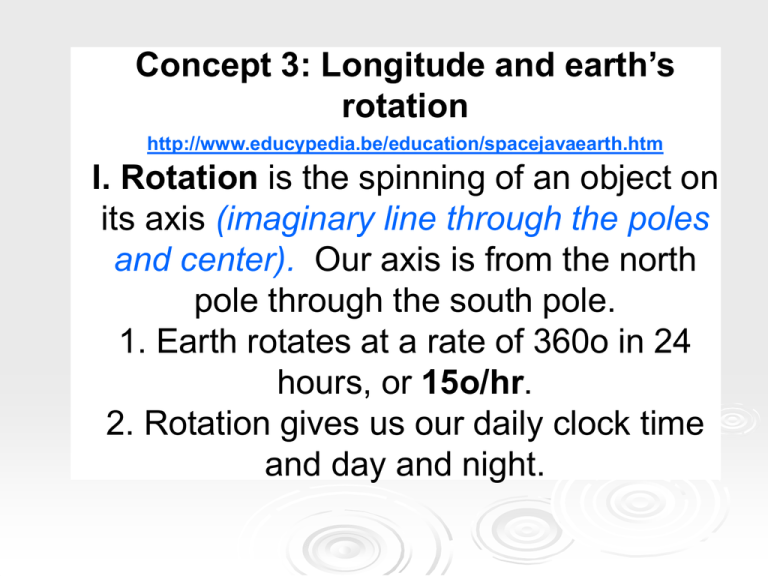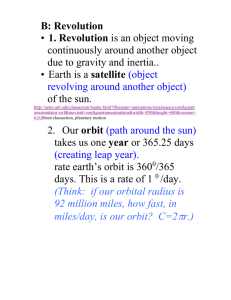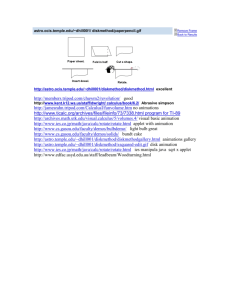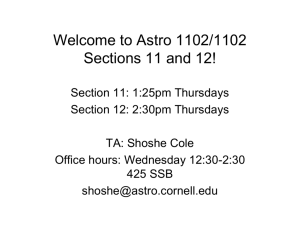I. Rotation
advertisement

Concept 3: Longitude and earth’s rotation http://www.educypedia.be/education/spacejavaearth.htm I. Rotation is the spinning of an object on its axis (imaginary line through the poles and center). Our axis is from the north pole through the south pole. 1. Earth rotates at a rate of 360o in 24 hours, or 15o/hr. 2. Rotation gives us our daily clock time and day and night. 3. The earth's true rotation makes the sun appear to move. This is called the sun's apparent motion. (How fast does the sun appear to move each day? The stars? The moon?) 4. The sun appears to make an arc through the sky at 15o/hr. 5. Because the earth really rotates from west to east, or counterclockwise, an observer (person standing in one spot on earth) anywhere on earth will see sunrise (sun appears over horizon in morning) towards the east and the sunset (disappear below the horizon in evening) towards the west. 6. Where the sun is during the rest of the day depends on the observer's latitude 7. For New York State, the sun is always in our southern sky during the day. 8. At solar noon we say the sun has reached its highest point of the day. In New York State, the sun is never ever ever directly over our heads. (In other words, the sun is never at zenith in New York State). 9. Evidence of rotation: a. Coriolis Effect is the deflection of wind and water from straight line motion. If the earth did not rotate, winds and water would not curve, they’d go in a straight line. http://www.classzone.com/books/earth_science/terc/content/visualizations/es190 4/es1904page01.cfm?chapter_no=visualization b. Foucault Pendulum appears to change direction in a circle during 24 hours. However, the pendulum is actually going in a straight line, it is the room that is rotating around it!!! http://en.wikipedia.org/wiki/File:Pendule_de_Foucault.jpg c. Circumpolar constellations (always above the horizon) move around Polaris during the night, giving the suggestion that we rotate. http://astro.unl.edu/classaction/loader.html?filename=animations/ancientastro/dipperclock.swf&mo vieid=dipperclock&width=850&height=340&version=6.0.0 Concept 3: Latitude, seasons and revolution 1. Revolution is an object moving continuously around another object due to gravity. Earth is a satellite (object revolving around another object) of the sun. http://astro.unl.edu/classaction/loader.html?filename=animations/renaissance/configurationssimul ator.swf&movieid=configurationssimulator&width=850&height=680&version=6.0.0 classaction, planetary motion from Our orbit (path around the sun) takes us one year or 365.25 days (creating leap year) at a rate of earth’s orbit is 3600/365 days, or 1 0 /day. Think: if our orbital radius is 92 million miles, how fast, in miles/day, is our orbit? C=2r.) Slide 24 3. Ancient proofs of earth's revolution: a. Seasons (change in weather in a cyclic fashion). The size of the sun changes during the year. We are CLOSER to the sun in WINTER. Parallax of stars: closer stars seem to shift position relative to farther stars during the year. Seasonal constellations: the constellations we see in fall are different than those we see in winter, spring, etc. The change is cyclic http://phys23p.sl.psu.edu/phys_anim/astro/embederQ4.10060.html earth orbit and seasonal stars Models of the Solar System (and universe) http://astro.unl.edu/naap/ssm/ssm.html Geocentric Model: earth-centered. Heliocentric Model: suncentered.(Copernican model) retrograde motion and the ptolemic and Copernican explanations http://alpha.lasalle.edu/~smithsc/Astronomy/retrograd.html ptolemic retrograde http://phys23p.sl.psu.edu/phys_anim/astro/embederQ4.20100.html copernican retrograde http://phys23p.sl.psu.edu/phys_anim/astro/embederQ4.20300.html 4. Causes of Seasons; a. Tilt of axis: our axis is tilted, with reference to the sun's rays, at an angle of 23.5o (look at any globe) http://astro.unl.edu/classaction/loader.html?filename=animations/coordsmotion/obliquity.swf&m ovieid=obliquity&width=600&height=400&version=6.0.0 b. Parallelism of the axis: our North Pole always points toward Polaris. (see wall chart) c. Revolution: We orbit the sun on a tilted planet, causing different parts of the earth to have more light seasonally. http://astro.unl.edu/classaction/loader.html?filename=animations/coordsmotion/eclipticsimulator.swf&movieid=eclipticsi mulator&width=970&height=710&version=6.0.0 5. Important dates: Equinoxes: “equal night”. Sun is overhead at equator. September 22 and March 21 Solstice: ‘sun stop’. Sun is either at Tropic of Capricorn (winter begins December 21) or Tropic of Cancer (summer begins June 21). Each day, the sun seems to move a little bit between 23.5 North and 23.5 South Actual position of sunrise changes with seasons, but is always east Position of sunset changes with seasons, but is always west. http://alpha.lasalle.edu/~smithsc/Astronomy/retrograd.html retrograde motion and the ptolemic and Copernican explanations http://phys23p.sl.psu.edu/phys_anim/astro/embederQ4.20100.html ptolemic retrograde http://phys23p.sl.psu.edu/phys_anim/astro/embederQ4.20300.html copernican retrograde http://astro.unl.edu/classaction/loader.html?filename=animations/renaissance/configu rationssimulator.swf&movieid=configurationssimulator&width=850&height=680&versi on=6.0.0 from classaction, planetary motion http://astro.unl.edu/classaction/loader.html?filename=animations/renaissance/ptolem aic.swf&movieid=ptolemaic&width=900&height=660&version=6.0.0 ptolemic phases of venus http://astro.unl.edu/classaction/loader.html?filename=animations/renaissance/retrogra de.swf&movieid=retrograde&width=700&height=600&version=6.0.0 retrograde animation http://phys23p.sl.psu.edu/phys_anim/astro/indexer_astro.html physics animations http://phys23p.sl.psu.edu/phys_anim/astro/embederQ4.10060.html earth orbit and seasonal stars C= 2 x 92 million x 3.14 = 580 million miles orbit Speed of orbit = 580 million miles / 365 days = 1.6 million miles / day Hours in a day = 24 Speed per hour = 1.6 million miles/ day x 1day/ 24 hours = 67, 000 mph




